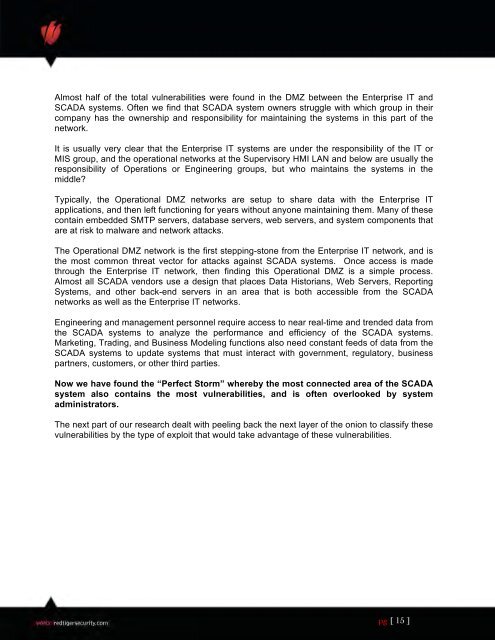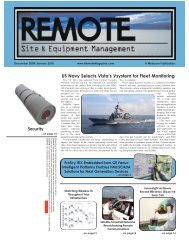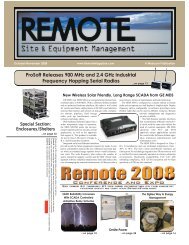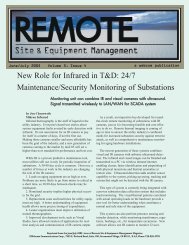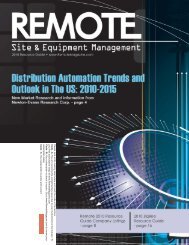Electricity for Free? The Dirty Underbelly of SCADA and Smart Meters
Electricity for Free? The Dirty Underbelly of SCADA and Smart Meters
Electricity for Free? The Dirty Underbelly of SCADA and Smart Meters
Create successful ePaper yourself
Turn your PDF publications into a flip-book with our unique Google optimized e-Paper software.
Almost half <strong>of</strong> the total vulnerabilities were found in the DMZ between the Enterprise IT <strong>and</strong><strong>SCADA</strong> systems. Often we find that <strong>SCADA</strong> system owners struggle with which group in theircompany has the ownership <strong>and</strong> responsibility <strong>for</strong> maintaining the systems in this part <strong>of</strong> thenetwork.It is usually very clear that the Enterprise IT systems are under the responsibility <strong>of</strong> the IT orMIS group, <strong>and</strong> the operational networks at the Supervisory HMI LAN <strong>and</strong> below are usually theresponsibility <strong>of</strong> Operations or Engineering groups, but who maintains the systems in themiddle?Typically, the Operational DMZ networks are setup to share data with the Enterprise ITapplications, <strong>and</strong> then left functioning <strong>for</strong> years without anyone maintaining them. Many <strong>of</strong> thesecontain embedded SMTP servers, database servers, web servers, <strong>and</strong> system components thatare at risk to malware <strong>and</strong> network attacks.<strong>The</strong> Operational DMZ network is the first stepping-stone from the Enterprise IT network, <strong>and</strong> isthe most common threat vector <strong>for</strong> attacks against <strong>SCADA</strong> systems. Once access is madethrough the Enterprise IT network, then finding this Operational DMZ is a simple process.Almost all <strong>SCADA</strong> vendors use a design that places Data Historians, Web Servers, ReportingSystems, <strong>and</strong> other back-end servers in an area that is both accessible from the <strong>SCADA</strong>networks as well as the Enterprise IT networks.Engineering <strong>and</strong> management personnel require access to near real-time <strong>and</strong> trended data fromthe <strong>SCADA</strong> systems to analyze the per<strong>for</strong>mance <strong>and</strong> efficiency <strong>of</strong> the <strong>SCADA</strong> systems.Marketing, Trading, <strong>and</strong> Business Modeling functions also need constant feeds <strong>of</strong> data from the<strong>SCADA</strong> systems to update systems that must interact with government, regulatory, businesspartners, customers, or other third parties.Now we have found the “Perfect Storm” whereby the most connected area <strong>of</strong> the <strong>SCADA</strong>system also contains the most vulnerabilities, <strong>and</strong> is <strong>of</strong>ten overlooked by systemadministrators.<strong>The</strong> next part <strong>of</strong> our research dealt with peeling back the next layer <strong>of</strong> the onion to classify thesevulnerabilities by the type <strong>of</strong> exploit that would take advantage <strong>of</strong> these vulnerabilities.pg [ 15 ]


